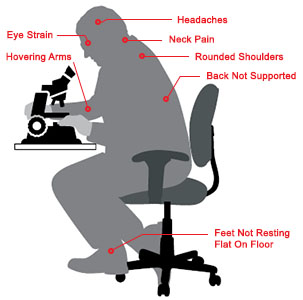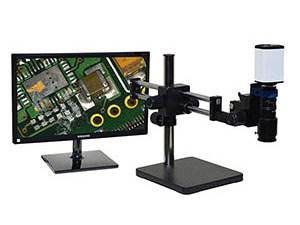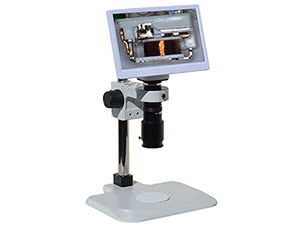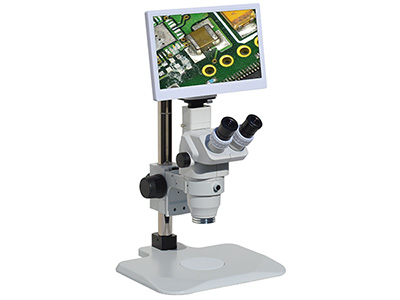If you go shopping for an office chair or keyboard, you may come across the keyword “ergonomic” in the product descriptions. Ergonomic design takes into consideration the user’s experience when using a product by designing in a way that promotes efficiency and comfort. You might not think it’s an important factor to consider when purchasing a microscope, but it may really save you a world of hurt (literally!) in the long run.
Some Statistics Advocating for Ergonomics in the Inspection Workplace

In 1997, the CDC released a report with evidence for work-related musculoskeletal disorders (MSD or WMSD), often resulting from routine heavy-lifting, daily exposure to significant forces, repetitive motions, awkward posturing and more. MSD are injuries or disorders of the muscles, nerves, tendons, joints, cartilage and spinal discs. Some common WMSD examples include carpal tunnel, back injury and chronic pain, and arthritis.
Further studies have been conducted since 1997, bringing into light the extent of long-term consequences of WMSD on the human body as well as economic losses for companies as a whole. The Institute of Medicine estimates that WMSDs cost between $45 and $54 billion annually in workers compensation, lost wages and lost productivity. WMSD are conditions in which:
- The work environment and performance of work contribute significantly to the condition; and/or
- The condition is made worse or persists longer due to work conditions
Of the two occupational groups that make up 54% of back injury cases, 38% consisted of operators, fabricators and laborers while 17% worked in precision production, craft and repair. This puts microscope operators at a particularly high risk for WMSDs due the constant awkward posturing and repetitive movements affiliated with their work.
Detrimental Effects on Microscope Operators
80% of microscope operators have experienced WMSD, with majority specifying neck, back, and shoulder pain as well as eyestrain and headaches as their ailments. 20% have also missed work due to these injuries and chronic pain.

When doing work on a traditional optical microscope, you are often seated for a prolonged period of time and leaning forward to view into the microscope eyepieces. The leaning position causes the back to move away from and not be supported by your chair. Your shoulders will also be rolled forward and your neck tilted forward to peer into the eyepieces. Additionally, your arms will be stretched out to support the inclined positioning of your body, generally resulting in a hovering position with no support from the benchtop.
The posture of a traditional microscope operator is fairly kinetic and doesn’t allow the muscles to relax. Due to the unnatural positioning your body needs to be in, this can often lead to physical discomfort while you work, which can be very distracting and decrease productivity. By the end of the work day, you may be left feeling muscle strains in your neck, shoulder, and eye strain and headaches from constant inspection through eyepieces.
Ergonomic Solution through Digital Microscopes
Eye-Level Viewing
In order for optical microscopes to be as ergonomic as possible, you have to take into consideration the overall microscope height and viewing angle of the eyepieces. Since each person’s stature is different, these need to be adjusted for each individual microscope operator’s specific needs for maximum optimization, which may consume more time and equipment costs if a microscope is used by various personnel throughout the day.
With the technology of digital microscopes, microscope operators will be able to view their inspections ergonomically through a monitor screen. A digital microscope monitor enables inspections to be done at eye-level and positioned to your preference. The monitor screen is often large enough to be eye-level for multiple operators of varying body heights without additional adjustments or equipment.


Digital microscopes allow operators to view inspection through a monitor screen,
which is more ergonomic than viewing through an optical microscope’s eyepieces.
For instance, our HD 1080p HD801 manual focus system can be paired with a 24” HD monitor, which can sit right on the bench top, perfectly at eye-level for a seated microscope operator. The system can also be paired with a 12” monitor, which mounts directly onto microscope’s camera body to save on table footprint while still maintaining eye-level display. The 12” monitor can even be installed to the side of the stand post for optimal ergonomic positioning.
Upright Body Posture

The digital microscope’s ability to display observations on a monitor plays a crucial role in improving the operator’s posture. Without having to peer through eyepieces, you do not have to endure awkward upper body posturing that may cause physical aches and long term consequences.
Since you no longer need to lean forward to see through the microscope, you can now sit up straight and with your back against your seat for extra support. Your feet can also rest flat against the floor, and your arms relaxed on the table top, both of which provide additional support and promote a relaxed body stance. A relaxed body means relaxed muscles, which will eliminate any muscle strain potential.
Microscope height is also no longer limited when inspecting from a larger monitor on the benchtop because you don’t have to position the microscope at a height reasonable for looking through eyepieces but may also jeopardize clearance needed for work under the microscope. Digital microscopes can be configured with different stand options, such as a universal boom stand or articulating arm stand, to provide the needed additional height to allow work with tools under the microscope without compromising your viewing capabilities.
Larger Image Display for Improved Focus

A monitor screen, regardless of the size, will also give you a larger viewing space to work with than eyepieces would. This makes it faster and easier to make more accurate examinations. Furthermore, having a monitor screen presents the opportunity to have open discussions with colleagues, which can improve thoroughness of inspection when other fresh eyes are able to examine the specimen. Looking through eyepieces on a traditional optical microscope for detailed inspection requires considerable concentration and focus, which can develop eye strain and headaches without proper rest breaks between usage.
Even if your work may require eyepieces for detailed inspections, a hybrid digital microscope can still reduce stress by letting you bring the image into focus through the monitor screen first before looking through the eyepieces for the final observations. For operators who do not want to completely give up using eyepieces, you can compromise by considering a system like our HD8TR trinocular digital microscope.
Most of our digital microscopes can be connected to a large 24” monitor screen that sits on the bench top. Those that want to save some footprint due to limited workspace can consider mounting a 12” monitor onto the camera body of the digital microscope, or on the post of the stand for ergonomic positioning. We actually recommend configuring our 4K Ultra HD systems with a 28” or larger UHD monitor in order to experience the benefits of 4K’s higher pixel count.
Higher Efficiency and Morale in the Workplace by Addressing Ergonomics
Physical aches, no matter how minute, can be detrimental your work morale if the discomforts are persistent and do not subside with time. Not only can these pains be distracting, they may even decrease your work capacity and performance. By minimizing any physical ailments microscope operators experience throughout the workday or chronically, you will improve their work quality and morale.
Maintaining positive outlook among the operators ensures that they don’t come into work dreading the uncomfortable side effects, and instead, can focus on conducting comprehensive and efficient inspections that meet quality standards. Addressing ergonomics by switching from traditional optical microscopes to digital microscopes can also reduce missed work days by operators due to chronic conditions stemming from prolonged microscope use, further boosting production times.
Contact us today for assistance on finding the right digital microscope for your application.
